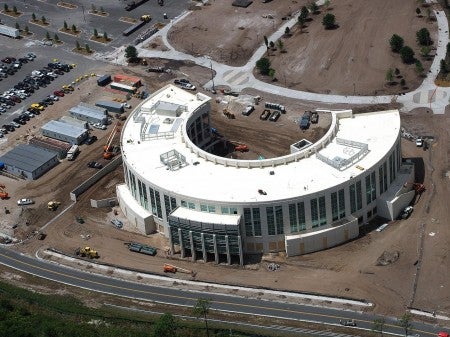 Orlando is getting healthier, both physically and economically. Much of the credit goes to what is called “Medical City,” a 600-acre park where half a dozen medical facilities are under construction in the Lake Nona development outside of Orlando.
Orlando is getting healthier, both physically and economically. Much of the credit goes to what is called “Medical City,” a 600-acre park where half a dozen medical facilities are under construction in the Lake Nona development outside of Orlando.
A new $655-million Veteran’s Affairs hospital is being built, so is a 95-bed children’s specialty hospital by the nonprofit Nemours Foundation. The University of Central Florida is building a medical school and the nonprofit Sanford-Burnham Medical Research Institute opened a 178,000 square-foot research facility a year ago.
Even with massive construction cranes scattered around the park, vast amounts of acreage waits for future ground-breaking ceremonies and development signs to promote more things to come. The city has a “bio Orlando” pitch.
Five years ago, none of it existed and the land was barren, much like the landscape in eastern Collier County where the Economic Development Council and local government leaders hope to build Collier’s version of a bio-medical park.
The starting point would be a $130-million local investment for the nonprofit Jackson Laboratory, based in Maine, to build a 165,000-square-foot genetics research facility near Ave Maria. The local money would be matched by the state and Barron Collier Co. has agreed to donate 50 acres for the project.
EDC and Collier officials look to Lake Nona’s medical city as a model of what could happen here, on a smaller scale, if the local community takes the leap. On Friday, the EDC sponsored a dozen civic and business leaders to visit Orlando’s bio-medical park.
“I was thoroughly impressed with the possibilities,” Dick Rice, executive director of the Eastern Collier Chamber of Commerce, said. “We don’t have to see it in the scale up there but I can see all sorts of possibilities.”
John Sorey, vice mayor for the city of Naples, likewise sees the potential for Collier.
“If we could do one-third of what they are doing, it makes sense,” he said. “If we can create 5,000 jobs, it would be a home run for Collier County.”
******
The EDC in Orlando tried to win the Scripps Research Institute when the state Legislature laid the initial groundwork in 2003 to start attracting bio-medical industries to Florida to promote economic diversity. Orlando lost to Palm Beach.
“It kind of hurt to lose Scripps because we wanted Scripps,” said Ray Gilley, president and chief executive officer of Metro Orlando EDC.
When the Legislature in 2006 designated $150 million to bring La Jolla, Calif.-based Sanford-Burnham to Florida, Orlando competed against Port St. Lucie.
“The second time I think we were more adamant,” Gilley said.
Orange County had to match the state money but came in with $228 million, factoring in funding from Orange County, the city of Orlando, private dollars and support from the Tavistock Group, the developer of the larger 7,000-acre Lake Nona planned development.
By 2017, the economic impact of Lake Nona’s medical city and related development is expected to be $7.6 billion with 30,260 jobs, with $2.8 billion in wages and $459 million in tax revenue, Gilley said. The current economic impact is $5.2 billion.
A boost is heightened awareness in Orlando toward better health and wellness, he said.
“It is something I don’t know if any of us thought about at the time,” Gilley said.
The Sanford-Burnham facility at build out in 2016 will have 300 employees, of which 250 will be scientists focused on therapies for diabetes and obesity. So far, the center has 150 employees and 90 scientists.
“Absolutely critical for our success is proximity to medical schools and universities,” said Stephen Gardell, director of translational research resources at the institute.
Sanford-Burnham’s facility in Orlando attracted nearly $40 million in grants its first year. Today many National Institutes of Health grants are for collaborative research, he said.
A newcomer to Orlando’s bio-medical park will be a University of Florida research program.
“We were absolutely thrilled when the University of Florida announced a regional facility is going in next door,” Gardell said. “Again, it’s about collaboration. We could not do this alone.”
*****
Although the Sanford-Burnham facility is the first to be completed in the medical park, it was not the medical entity that launched the park.
Veterans and Orlando residents had clamored the VA for a hospital for decades and finally saw the federal funding in 2006, said Courtney Franchio, spokeswoman for the Orlando VA.
“We were going to have a facility whether the medical city was there or not,” she said.
Lake Nona was finally chosen because UCF’s medical school was going there.
“While the UCF College of Medicine was the driving force, we are excited that Sanford-Burnham is there,” she said.
In a similar vein, Nemours first sought state approval in 2005 to build a specialty children’s hospital in Orlando before Sanford-Burnham came on the horizon.
Nemours initially purchased land elsewhere and moved the location to Lake Nona because of UCF’s medical school and because Sanford-Burnham was going there, said Nemours spokeswoman Karen Breakell said.
Being in the vicinity of Sanford-Burnham, the medical school, the VA hospital and future UF program helps with recruiting.
“The value of bio-medical clustering is like-minded people like to be together,” she said.
Source: NaplesNews.com, Collier leaders visit Orlando’s ‘Medical City’ for economic potential, by Liz Freeman, Friday, June 18, 2010. Connect with health-care reporter Liz Freeman at www.naplesnews.com/staff/liz_freeman.